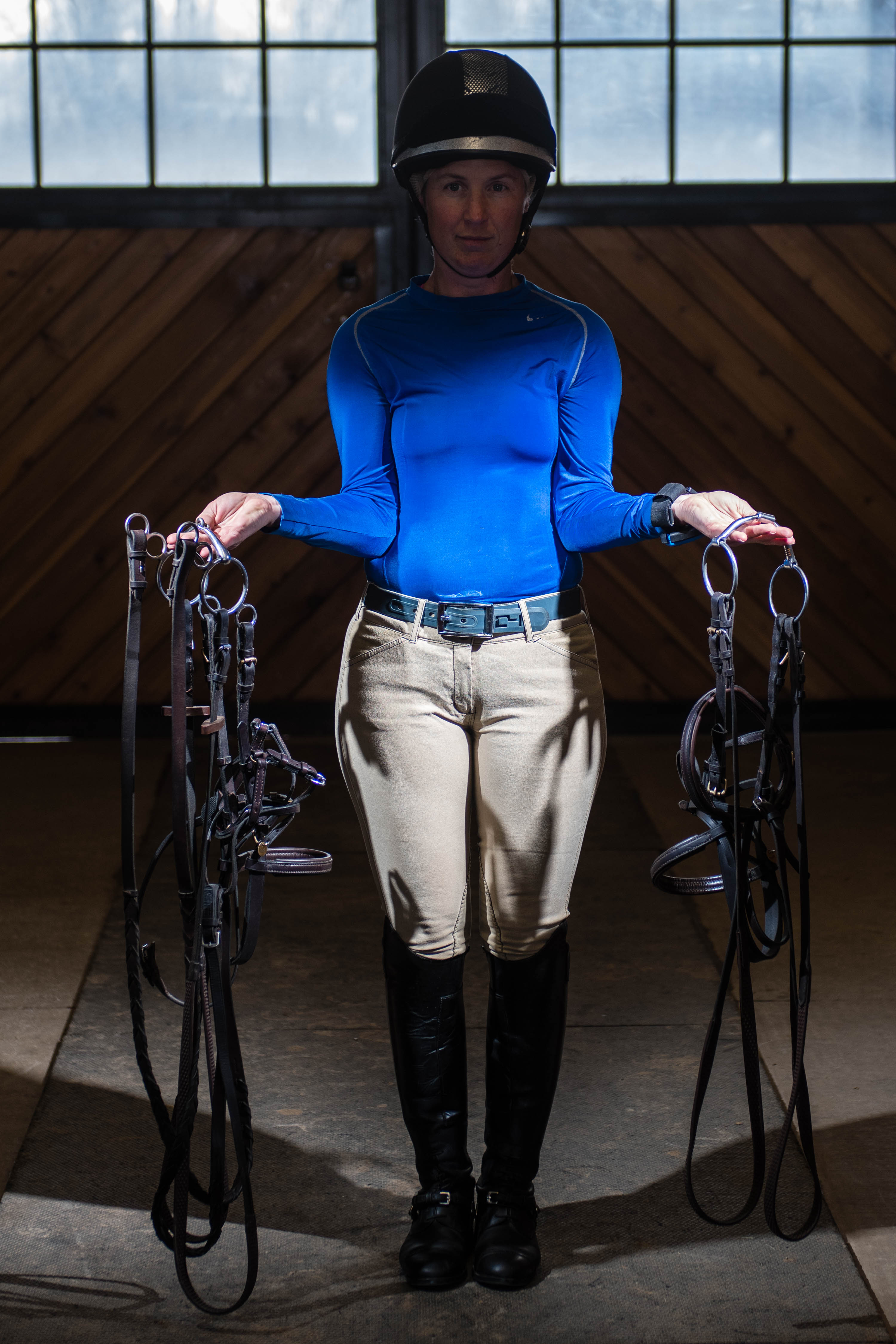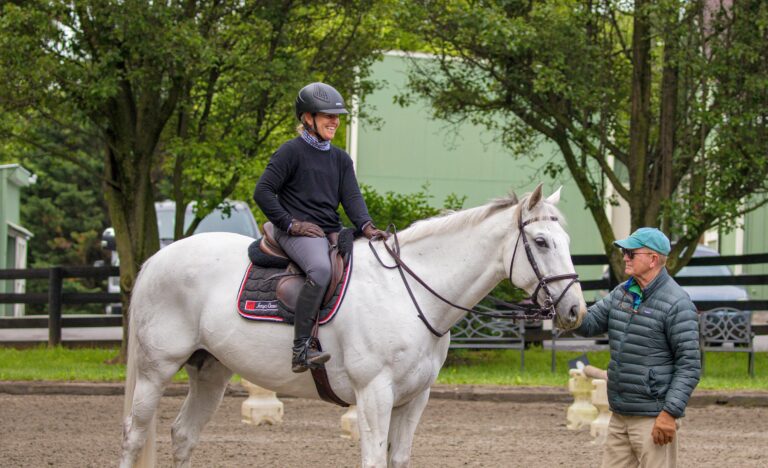
This is the season when I get stuck in what Merriam-Webster’s dictionary calls a “conundrum,” an intricate and difficult problem. Let me describe my conundrum in two simple sentences, both of them true:
1. You should train your horse using only classical methods, chief among them being the use in dressage of a plain snaffle with a cavesson fitted correctly. (By “classical” I mean that you do not ask your horse to do anything he does not do in nature and that you do not resort to compulsion to achieve your goals.)
2. If you don’t have enough bit, you can’t have good hands.
You see the conundrum? These two statements, while both true, are antithetical. My problem is that I make my living at the nexus of these two principles. Like most trainers, I bounce back and forth between these ideas based on the time of year. If it is a quiet time with no competitions planned, then all I need for my students and their horses is a simple snaffle, a loose noseband and good footing. But once “they”—judges and timekeepers—start keeping score? That’s a horse of a different color because the reason for all that classical training is to help us become better competitors.
Competition’s Effect on Training
Let me give you an example. Take a hypothetical rider: She is 5-foot-4 and is in better-than-average physical condition. Her skill set is sufficient for her level and she works weekly on improving her technique and her horse’s responses. Her OTTB horse is slightly too big for her and tends to get strong at competitions, especially during cross country. He was purchased for her to compete at the present level but with his former (professional) rider has successfully completed the next higher level.
This rider’s position is good on the flat, and although when jumping she misses her distances on a regular basis, she is learning to depend on her rhythm and her horse is starting to think for himself. Their jumping skills are average, but her horse is a good athlete and is starting to understand that his job is to keep her out of trouble.
Looking at this resumé, one might think, “no problem, good to go.” But not so fast (literally and figuratively). Left to his own devices, her horse will take a keen interest in his cross-country work, especially in the heightened atmosphere of a competition with strange horses around and his owner (probably) a little nervous. At her final event last fall, my hypothetical rider was approaching yellow-card territory when she crossed the finish line. That plain snaffle she used probably had something to do with her horse’s velocity.
At this point I laugh at myself because my answer to the problem this horse and rider pose is entirely based on where we are on the competitive calendar. If it is early in the calendar, my answer is invariably, “Improve your dressage, work in a plain snaffle, no gadgets,” and so on.
But remember your Ecclesiastes? “To every thing there is a season and a time to every purpose under the heaven.” For me, this means there is a time for snaffles and a time for stronger bits. I don’t mean that I give up trying to improve my horses and riders by classical training at home once the competitive season is under way, but that I am open to stronger/different bits for competition. After all, they are keeping score!
For example, I am willing to consider using a gadget bit (for me, a gadget bit is anything more than a simple loose-ring or egg-butt snaffle). What sort of gadget bits do I suggest? That depends on how your horse misbehaves: If he drops his head, use a gag; if he pulls straight out, use a bit with a corrugated surface; if he inverts, use a bit with a curb chain. These are sweeping generalizations, and you will have to experiment until you find the right bit. But once I find a bit that works, the only time my rider will use that bit is at a competition. The rest of the time it stays in the tack trunk. At home we will continue to emphasize correct training.
My point here is that you should not train at home in a gadget because by doing so, you are, in effect, lying to yourself about your state of training. In addition, if you continue to use a gadget bit on a horse who has flaws in his training, he will learn to ignore it. We need to train correctly at home, but we need a competition to measure how well we have trained our horses—and sometimes we need a little extra help from the bit to take that measure safely.
They’re Keeping Score—And You’re Ready
Since the competitive season has begun in most parts of the country, I am going to assume that your dressage is going well, that your horse has done the necessary long slow work to establish his fitness and that at home he is cantering quietly over jumps set at the appropriate height and spread. If we are going to compete, we might as well be successful, so the following are some tips to help you improve your results.
By now you should have renewed your memberships in the various national and local organizations involved in your target events. Once you arrive at the competition grounds, check in and pick up your packet. The show secretary and her assistants behind the counter are volunteers, giving their valuable time so that you and your horse can have a good experience. Be nice.
Once checked in, you will be in a hurry to get your horse off the trailer and into his assigned stall. But take a minute to check the stall for nails, broken boards and other hazards. Chances are you will have gotten your start times from the internet and should have a fairly accurate idea of what you will be doing the rest of the weekend and when. Make a detailed schedule for all three phases. Start by finding your dressage time because everything you do with your horse between your arrival on the grounds and the time you start down the centerline is dedicated to having him in the best physical and mental condition for your test. Where can you warm up? When are the show-jumping and cross-country courses open for walking? Write it all down so that you can relax and do a good job.
By now you should understand your horse and plan accordingly. If you have a calm, experienced campaigner, you need not fear an 8 a.m. dressage time tomorrow. However, if your horse is excitable or easily upset by changes to his environment, then it is going to be an early start for you in order to get him to the ring calm and focused. You have already determined your horse’s warm-up pattern. What is he like on the day after an intensive dressage lesson? Is he better or is he stiff and needing an easy day? If your work yesterday consisted entirely of long-and-low, stretchy circles, what is he like today? There is no absolute right or wrong answer, but you need to know how your horse reacts to various situations to produce the best possible dressage score. (Also keep in mind that this warm-up pattern may change during the season due to your horse getting fitter.) One final point about this phase: learn your dressage test and practice it with your horse. Study the criteria for each movement. You will find some of the movements easy for your particular horse while others seem more difficult. Plan to show him off where you can and ride conservatively where you might have a problem. Remember, the judges are keeping score so try to get every possible mark on each movement.
Bring Your Best to the Jumping Test
Once you have the hard part behind you, let’s talk about the jumping phases. By now you should have walked both the show-jumping and the cross-country courses. At some events, show jumping follows dressage while other events schedule show jumping to take place after dressage and cross country. Each format has good and bad points, and you should be aware of them. Let’s take show jumping after dressage because it is common to have this sequence at local events due to the schedule for different levels—Novice, Training, etc. You should already know your horse’s jumping warm-up pattern and if you have competed, you should know how he reacts to competitive circumstances, for example speeding up as he goes around the course or getting slightly behind your leg when in a new ring. If you know these details, you are halfway to solving them already.
Walk the course at least twice and several times if you can. The first time, just learn your way around. The next time, analyze the parts that will be easy for your horse and the parts that will be difficult. Whatever the type of horse, a good show-jumping course will have portions that are difficult and portions that are easy.
Always look for an opportunity to possibly make a quick turn so that you don’t have the feeling that you have to hurry. Your practice at home should include turning exercises, and you should also practice jumping at the height and spread of your level so that things don’t look big to you when you walk the course.
Once it is time to warm up, keep in mind the time between your dressage test and your show jumping. If you did your test an hour ago, all you need to do is change your saddle and bridle and head for the warm-up ring. You might have decided to use a stronger bit, which is fine if you have practiced with it before the competition. Don’t make a drastic bitting change unless you have experimented with it first. I have already discussed my rule of thumb for what type of gadget bit to use, depending on your horse. Arrange to have someone on hand to set fences for you, and discuss your warm-up plan with them so they can have the obstacles ready for you.
Quite often, riders do not use the warm-up ring correctly. They view it as a place to take lessons and to jump far too much. You know your horse and you know your plan, so quietly go about your business. Do not ride endless circles at one end of the warm-up ring, bellowing “oxer” at the top of your voice. Most of the other riders are too scared to hear you and the professionals will ignore you. Finally, accept that you will be nervous, so don’t suddenly become a “stride Nazi” to try to compensate. Depend on your rhythm and your horse, not your eye.
At this point, you are thinking, “Phew, got through dressage and show jumping, at least now I get to go cross country.” Cross country is the reason most of us event and is certainly my favorite part of the competition. As you might expect, I have strong opinions on cross country, opinions that you will find in my next column, so don’t forget to renew your subscription.
Practical Horseman thanks Doug and Cindy Howe for the use of their Somehow Farm in Cochranville, Pennsylvania, for our photo shoot.
This article was originally published in the April 2018 issue of Practical Horseman.










